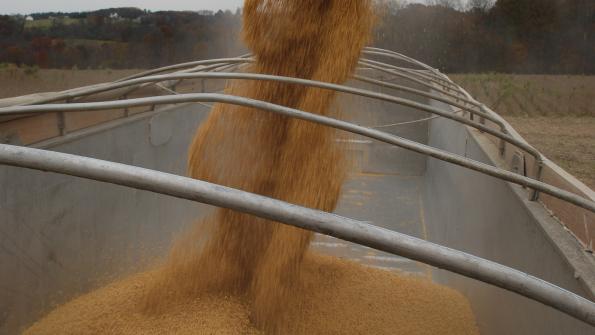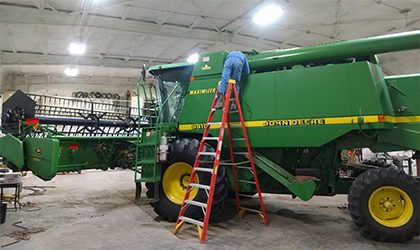September 27, 2018

Source: South Dakota State University
This article is part 2 in a 4-part series focusing on grain storage.
By Ruth Beck, Sara Bauder, Laura Edwards, Nathan Edwards, Anthony Bly, David Karki, and Jack Davis
As producers prepare to fire up combines for the 2018 fall harvest, there is much concern about commodity prices and markets. Many producers realize that it will be difficult to sell soybeans for the foreseeable future and are making preparations to store this commodity for a number of months or possibly longer. Other commodities are also slow to move and storage could be at a premium this year on many farms.
Prepare bins and service equipment
Making sure that products store well begins before harvest. Bins should be cleaned thoroughly prior to harvest. Information on preparing bins for harvest can be found in How to Prevent Stored Grain Pests.
The condition of the grain at harvest will affect the storability of the commodity. Dirty and damaged grain with lots of foreign material does not dry or store well. Combines should be serviced and properly prepared so they are ready for harvest. Producers may want to consider replacing worn parts as these can contribute to damaged and lost grain. Worn gathering chains, stalk rolls, snapping bars, feeder house conveyor chains, concaves and rasp bars can lead to ear shatter and threshing losses. Take the time to set the combine with the correct rotor speed and concave clearance for each crop. Initial settings should be made according to the operator’s manual, with further adjustments made in the field to correct for field conditions. Operators should inspect the grain in the tank after harvesting a small portion of the field. Evaluate the grain for proper threshing and cracked kernels; adjustments can be made at this time. It is recommended that one adjustment be made at a time. Then, check results before making other adjustments. It is important to check for grain loss and damage frequently, particularly as harvest conditions change.
Conditions at harvest
Most producers will allow corn to dry in the field until grain moisture ranges between 18 and 25%. The optimum moisture content for limiting mechanical damage during harvest is 22%. Increased damage occurs both above and below this moisture content. Harvesting too soon can also result in higher drying costs. Corn will need to be 15.5% moisture for winter storage, 14% for storage through summer, and 13% for long-term storage.
Harvest timing of soybeans will impact grain quality. The optimum soybean harvest moisture is between 13-15 %. Soybeans with moisture at or below 11% will be more prone to shatter and cracking. Harvesting soybeans at 15-18% moisture can also result in significant losses. Cracked seed and high moisture soybeans will reduce storability. Soybeans are relatively easy to thresh and separate, and most harvest losses occur at the combine head. The cutting system should be examined and maintained prior to beginning soybean harvest. This helps to avoid incomplete cutting of stems, which can result in harvest losses.

Weed seeds, chaff and wet grain can impact the drying process and the movement of air through the stored grain. It may be worth the extra time to combine these areas at a later date when weeds have died and grain is dryer.
Handle grain gently
Select conveyors that are gentle on the grain and operate them in manner to reduce damage. Augers are not a primary source of grain damage if operated properly. Reducing auger speed and operating the auger at full capacity reduces the risk of kernel damage. Drop height should be minimized during grain transfer.
Drying
Although field drying is a popular option for South Dakota producers, many producers use other methods to dry grain further after harvest. Wet, humid, fall weather is not uncommon and producers need the capability to dry grain during those conditions. This year with the real possibility of long-term storage for commodities, drying systems can be used to fine tune the moisture of grains and prepare them for long term storage. Grain drying options include; natural air drying, low temperature drying, high temperature drying and a combination of these or dryeration. The same equipment can be used for both soybeans and corn. Detailed information on drying options can be found in this Grain Drying publication by Dr. Kenneth Hellevang (NDSU).
A number of tests on drying seed grains show that germination drops rapidly as the seed kernel temperature goes above 120°F. For this reason, it is recommended that a maximum of 110°F air be used on any grain slated to be used for seed. If drying soybeans for non-food markets, the heat should not exceed 130°F because the seed coats will crack. Natural or low temperature drying is recommended for soybeans slated for food or seed markets. Information and a table showing maximum recommended drying air temperatures for several grains can be found in this Grain Drying publication.
Drying costs
Grain drying costs will run higher this year due to increased fuel prices. Propane costs have increased from last year and they make up a significant part of drying costs. Producers must evaluate their harvest loss risk from allowing the crop to dry more in the field vs. harvesting earlier and drying. On-farm drying includes fixed costs such as depreciation and interest plus the operating cost of electricity, fuel, and handling loss. Operating costs to dry corn 5 points are estimated at $0.10 to $0.12 per bushel, electricity at $0.01, handling costs of $0.06 to $0.08, and fuel from approximately $0.10-$0.12 per bushel. Commercial cost will include drying cost, shrink, and additional elevator fees. These costs will have to be weighed against the cost of letting the crop dry more in the field if needed.
These decisions are not easy, but attention to detail and care in handling at harvest, will help producers maintain quality in corn and soybeans for the short and long-term.
Originally posted by South Dakota State University.
Check out Part I here, Part III and Part IV here.
You May Also Like




